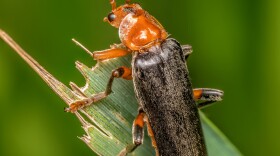We all get a little confused sometimes. But if that confusion grows to the point where it is noticeable to others, some one might say, “You look as if you don’t know whether you’re coming or going.”
While not a compliment to us humans, it might be a very good thing if you’re an insect that’s on the menu for a variety of potential predators. But in this case it’s not the insect that’s confused, it’s what happens to potential predators that are hunting it.
Called hairstreaks, groundstreaks, or ministreaks, we’re talking about a specific subfamily of butterflies that have an amazing ability to confound predators.
Aside from the fact that many of these species of small butterflies are strikingly beautiful, most have one or two hair-like tails sticking out of the lower, rear portion of each hindwing. Coupled with a colored mark just below these hairs, the deception is nearly complete.
With the hair-like tails looking like a pair of antennae and the colored marks looking like eyes, it appears that the butterfly has two heads.
But appearance alone is not enough. The finishing touch is in the butterflies’ body motion, constantly rubbing their hind wings together when perched to make it look like the antennae are moving.
And as the saying goes, “Two heads are better than one.”
Not sure which head to go after, predators (like birds) often attack the wrong one, ending up with a beakful of wing parts, rather than a meal.
While butterflies that lose a small portion of their wings live to see another day, we certainly can’t say the same for the butterflies that needed to improve upon their illusion.





